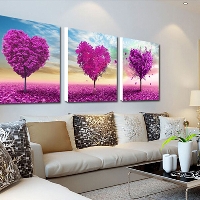
Decorate with triptychs — art in three parts
A triptych (trip-tick) is artwork in three parts. While a literary or musical composition can also be a triptych, here we are concerned with art, be it paintings, photographs, or display items. A triptych’s three parts do not necessarily have to form a coherent, single image, but most traditional triptychs use this approach.
Perhaps the most famous triptych was created by Claude Monet. His Agapanthus Triptych is 42 feet long. Each panel is seven by fourteen feet. The work took him ten years to complete. Practicality might be one reason Monet composed on separate panels. A single canvas like that today would require a semi truck and trailer to move. It’s this practicality that often shines when decorating with a triptych. And there are other reasons as well.
Many online artwork stores provide some outstanding examples of modern day triptychs. Look for categories like “Three Piece Paintings.” Let’s consider the different types.
~
In many triptychs, as in the featured image for this article, the three paintings are alike but slightly different. That produces an impact not achieved by one work alone. If you think of Andy Warhol paintings, one soup can was interesting enough, but several in series worked even better.
Another type is the single image broken into parts, just like with Monet. Besides being easier to ship and handle than a full scale artwork, the broken painting is arresting for its mosaic like design. Our eye wanders from panel to panel, the space between the images offering relief, making each part stand out or “pop”.
The last common type is the collection, where a theme like Hollywood is brought to life. An example might be one part Marilyn Monroe, one part Bette Davis, and one part Lauren Bacall. If you don’t find a packaged triptych that you like, think of doing your own.
Some companies offer wall hangings and frescoes suitable for a dynamic three piece installation. Through their partners they sell a wide range of vintage posters and art posters. As well as a selection of framed art prints. Speaking of which, there is another outlet you should be familiar with.
Museum stores are a natural place to look for studio prints and other suitable material. I noted that Japanese digital reproduction prints are the same paper size, making them ideal for any room needing an Asian accent triptych.
You can also look for a wide selection of tin signs that could be made into a highly creative triptych, perhaps for the garage. No frames needed. Motor oil signs, Route 66 signs, and automobile manufacturer signs could liven up your garage or work space with a three piece installation.
What else? Don’t pick something too dark. Most people like their rooms bright and airy and artwork should stay that same way. Key the art to the room’s mood and purpose if you like. Kitchens might inspire food themes, children’s rooms fantasy characters, action scenes for activity rooms, tranquil art for bedrooms and so on.
Now, what about the installation? There’s an art to placing art. Among the notable points, if possible, install your work above a fireplace, sofa, headboard, or dining table. Museums say eye level height works best. 4’9″ to 5’0″ is a good target. A triptych, by the way, doesn’t have to have all its parts at the same level. Something more dynamic happens if you stagger pieces at different heights.
In summary, look around for artwork that inspires you in thirds. You might be surprised at what life offers you, one piece at a time.
